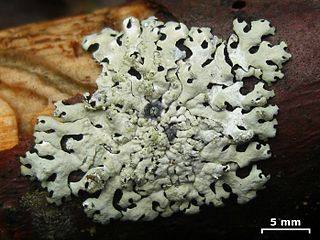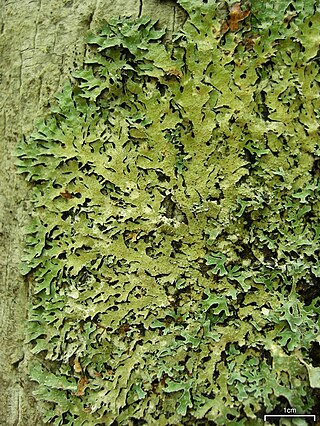
The Parmeliaceae is a large and diverse family of Lecanoromycetes. With over 2700 species in 71 genera, it is the largest family of lichen-forming fungi. The most speciose genera in the family are the well-known groups: Xanthoparmelia, Usnea, Parmotrema, and Hypotrachyna.

Pseudevernia is a genus of foliose lichens in the family Parmeliaceae. The type species of the genus, Pseudevernia furfuracea, has substantial commercial value in the perfume industry.

Hypotrachyna is a genus of lichenized fungi within the family Parmeliaceae. According to the Dictionary of the Fungi, the widespread genus contains about 198 species. Hypotrachyna was circumscribed by American lichenologist Mason Ellsworth Hale Jr in 1974.
Remototrachyna is a genus of foliose lichens in the large family Parmeliaceae. It was separated from the genus Hypotrachyna based on the structure of the excipulum and genetic differences.
Hypotrachyna is a species of foliose lichen in the family Parmeliaceae. Originally described from specimens collected in Venezuela, it is found in mountains throughout the Neotropics, where it grows on pine and hardwood bark.
Hypotrachyna aspera is a species of foliose lichen in the family Parmeliaceae. It occurs in the mountains of Minas Gerais and Paraná, where it grows on tree bark in humid forests at an elevation of about 1,100 m (3,600 ft).
Hypotrachyna boquetensis is a species of foliose lichen in the family Parmeliaceae. It was first described scientifically by lichenologist Mason Hale as a member of the genus Parmelia; he transferred it to the genus Hypotrachyna a year later. It is found in the mountains of Central and northern South America, where it grows on hardwood trunks and branches at elevations of 1,400–2,800 m (4,600–9,200 ft). It has also been recorded from India.
Hypotrachyna brevirhiza is a species of foliose lichen in the family Parmeliaceae. First described as a species of Parmelia by Syo Kurokawa in 1964, Mason Hale transferred it to the genus Hypotrachyna in 1975. The lichen is widespread in Central American Mountains and in the Andes at elevations of 2,700–4,300 m (8,900–14,100 ft), where it grows as an epiphyte on exposed trees and shrubs. It also occurs in southern South America, Africa, India, Indonesia, Papua New Guinea, Macquarie Island, and the Pacific.

Punctelia rudecta, commonly known as the rough speckled shield or the speckleback lichen, is a North American species of foliose lichen in the family Parmeliaceae. This species can be readily identified by the light color of the thallus underside, the relatively large lobes at the edges of the thallus, and the tiny white pores present on the top of the thallus that are characteristic of the genus Punctelia. The lichen is quite abundant and widespread in the eastern and southeastern United States, although it also occurs in Canada and northern Mexico, but is less common in these regions. The lichen usually grows on bark, and less commonly on shaded rocks. There are several lookalike Punctelia species; these can often be distinguished from P. rudecta by differences in distribution or in the nature of the reproductive structures present on the thallus.

Punctelia caseana is a species of foliose lichen in the family Parmeliaceae. Its range covers eastern North America, extending south to central and northern Mexico, where it grows on the bark of many species of hardwood and conifer trees.

Punctelia appalachensis, commonly known as the Appalachian speckled shield lichen, is a species of foliose lichen in the family Parmeliaceae. It is found in the eastern United States and eastern Canada. The lichen was first formally described in 1962 by lichenologist William Culberson as a species of Parmelia. He collected the type specimen growing on tree bark in West Virginia, Hildur Krog transferred it to the newly circumscribed genus Punctelia in 1982.

Punctelia reddenda is a widely distributed species of foliose lichen in the family Parmeliaceae. It occurs in Africa, Europe, North America, and South America, where it grows on bark and on rock.

Punctelia bolliana, the eastern speckled shield lichen, is a species of foliose lichen in the family Parmeliaceae. It is found in North America, with a distribution extending from the Canadian province of Ontario south to the central and northeastern United States and Mexico. It grows on the bark of both deciduous trees and coniferous trees. The combination of characteristics that distinguishes this species from others in genus Punctelia are the absence of the vegetative propagules isidia and soralia, a pale brown lower thallus surface, and the presence of the secondary chemical protolichesterinic acid in the medulla.
Parmelia mayi is a species of foliose lichen in the family Parmeliaceae. It is found in the northern Appalachian Mountains of eastern North America, where it grows on rocks and on the trunks of paper birch and balsam fir. Parmelia mayi is morphologically indistinguishable from Parmelia saxatilis, but is distinct in its distribution, chemistry, and genetics.

Fuscidea appalachensis is a species of saxicolous (rock-dwelling) in the family Fuscideaceae. Found in North America, it was formally described as a new species in 2008 by lichenologist Alan Fryday. The type specimen was collected from top of Tabor Gully in Baxter State Park (Maine) at an elevation of 1,415 m (4,642 ft). Here it was found growing on damp rocks on the side of the gully. The pale grey crustose thalli of Fuscidea appalachensis are 1–2 cm (0.4–0.8 in) in diameter, although neighbouring lichens may coalesce to form larger thalli. The lichen contains divaricatic acid, a secondary compound that can be detected using thin-layer chromatography. The specific epithet alludes to the range of the lichen—the Appalachian Mountains in eastern North America, ranging from New Brunswick to Tennessee at the southern end.

Hypotrachyna osseoalba, commonly known as the grainy loop lichen, is a species of foliose lichen in the family Parmeliaceae. It is widely distributed in subtropical and temperate areas of the world. Characteristic features of the lichen include the pustules in its cortex, the somewhat linear shape of the lobes comprising the thallus, and the branched rhizines.

Parmelia squarrosa, commonly known as the bottlebrush shield lichen, is a species of foliose lichen in the family Parmeliaceae. It occurs in east Asia, Europe, and eastern North America, where it typically grows on tree bark, much less frequently on rocks, and rarely on moss. Because of its abundance, widespread distribution, and stable populations, it has been assessed as a species of least concern by the International Union for Conservation of Nature. Parmelia saxatilis is quite similar in appearance Parmelia squarrosa and the latter was quite often confused with the former, especially in herbarium collections. Molecular phylogenetic analysis proved the genetic distinctness between the two species, which are morphologically distinguished by difference in rhizine structure.
Hypotrachyna constictovexans is a little-known species of foliose lichen in the family Parmeliaceae. Known only from a single specimen collected in 1976, it is found in the highlands of Peru. Its thallus can grow over 5 cm wide, featuring long, straight, and separate lobes that are highly convex and tube-like, with a pale grey, slightly shiny upper surface adorned with cylindrical isidia.
Hypotrachyna mcmulliniana is a species of foliose lichen in the family Parmeliaceae. It has a blue-grey thallus about 3-10 cm wide, with lobes 1.0–4.0 mm wide, and isdia without hairs.
Hypotrachyna kauffmaniana is a species of blue-gray to gray foliose lichen in the family Parmeliaceae. This species can only be located in eastern North America along the Appalachian Mountains, commonly found in Georgia, South Carolina, North Carolina, and Tennessee. The habitat of H. kauffmaniana is typically mid-elevation forests on both hardwood and conifer tree branches/trunks within the southern Appalachians. On rare occasions, this species can be found growing on non-calcareous rocks. H. kauffmaniana gathered its name in honor of Gary Kauffman, a botanist for the National Forest Service. H. kauffmaniana can be commonly confused alongside Hypotrachyna showmanii, but is distinguishable due to the former producing different levels of gyrophoric acid as well as possessing slightly different morphological properties.









